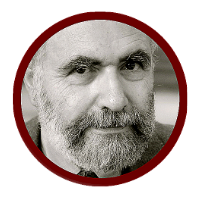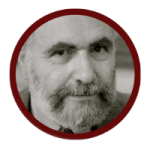Stéphane Frédéric Hessel's best-selling brochure helped launch the movement.
A little more than 13 months ago, a left-wing French publishing house specializing in Third World advocacy published a very short (32 pages) and very cheap (three euros) political brochure titled Indignez-vous! (Time for Outrage!).
The author was nonagenarian Stephane Frederic Hessel: a Nazi camp survivor, a former ambassador, and a regular French talk show guest. The booklet was an instant bestseller: one million copies in the first ten weeks, 1.5 million in the first year.
It still remains, as of today, the number one book on French bestseller lists.
The reasons for such a stunning success were quite obvious. Those people who read a bit, but not much, were thrilled to buy what passed for a serious essay by an important person for less than the price of a magazine. They were even happier to find out that Hessel’s philosophy was a perfect fit for their own intellectual and ethical size.
The Great Old Man urged contemporary youth to get “outraged” about poverty and injustice and to fight for a better world, just as he had done seventy years earlier as a member of the anti-Nazi Resistance. Who on Earth would contend with that, especially when the enemy was not the Third Reich, but benign modern democracies?
Moreover, the villain Hessel repeatedly mentioned and attacked was Israel — the country most people in France love to hate already.
Hessel’s booklet was almost as successful worldwide as in France proper. It was quickly translated and published in ten European languages and in Hebrew; overall sales hit 3.5 million copies. Translations were then produced in ten more languages.
The only exception in terms of popularity was the U.S.: the pamphlet was just inserted in The Nation’s April 7-14 issue. Practical Americans, even of the liberal persuasion, apparently had trouble selling it or buying it as a book.
Hessel’s influence on the ground grew to dwarf his sales accomplishments.
“Outraged” movements claiming to follow the old Frenchman’s philosophy bloomed in countries hit by recession or bankruptcy, like Spain, Greece, the UK, Chile, and more recently the United States. Strangely enough, even Israel — in spite of its comparatively good economic and financial shape and Hessel’s rabid anti-Zionism — was hit by the movement last summer.
All “outraged“ movements tended to follow a single pattern. Citizens with no explicit political affiliation “occupied“ major streets, squares, or public spaces for days or weeks, day and night, insisting upon “social justice” or “change.” They erected little booths and tent villages, both in order to sleep there and to make it more difficult to be moved out or blocked by police the following day.
Most democratic governments were reluctant to suppress such behavior, even if they were legally entitled to do so. In some countries, like Spain, there might even have been a not-too-secret understanding between the left-wing cabinet poised to lose the coming election and the demonstrators, who disclaimed in advance whatever measures a future conservative cabinet would take. (Jose Luis Rodriguez Zapatero’s socialists lost to Mariano Rajoy’s conservatives on November 20.)
Clearly, the so-called Arab Spring was connected to Hessel’s “outraged“ campaign. The demonstrations and sit-ins that led to the eviction of both Zine el-Abidine Ben-Ali in Tunisia and Hosni Mubarak in Egypt were modeled after Spain’s Indignados operations. This factor might not have been decisive by itself, but it did deter Western powers from extending support to leaders who were previously their local allies.
The much more complex Libyan, Yemenite, Bahraini, and Syrian upheavals started as replicas of the Tunisian and Egyptian revolutions. There was evidence of direct contacts between Arab insurgents and Western “outraged“ groups or Western NGOs close to the global “outraged“ movement.
As for the Israeli replica, it was launched in part by left-wing activists close to similar American and/or European NGOs, and was designed at some point as a tool to topple the Netanyahu cabinet. It didn’t work out that way: the core of the local “outraged” Israelis were just democratically minded patriots complaining about supposed negative byproducts of a two-decade economic boom, like the rise of real estate prices in cities like Tel Aviv and Jerusalem.
Hessel may not have been the real thinker and promoter of his movement.
At 93 (last year) and 94 (now), he seems to enjoy excellent health and clarity of thought. He may indeed have written the few pages that turned him into an instant world icon. However, the pages were more likely provided by a ghostwriter. A convincing argument, in this respect, is that Time for Outrage! is a “party line“ operation. It is less about Hessel expressing his views than about others setting an agenda and Hessel endorsing it.
The very concept of getting “outraged“ was already successfully tried in 1996 by another French author with similar political views. Viviane Forrester authored the much lengthier but equally thin in intellectual terms L’Horreur Economique (The Economic Horror). As for the tent villages on public space, that had been tested in Paris from 2006 to 2009 by “Les Enfants de Don Quichotte” (“Don Quixote’s Children”), a group agitating for housing rights.
In his recently released book Red Army, Aaron Klein argues that the old radical and pro-Soviet networks of the Cold War era have resurfaced in contemporary American politics. This powerful organization helped Barack Obama conquer the Democratic Party and then the White House, and this American Red Army, as he calls it, stands behind the Occupy Wall Street movement.
What Klein says about the U.S. is true of many other countries as well. Most of the radical groups that have been operating in Western countries since the mid-90s — from the anti-globalist and Green movements to the Islamists and anti-Israel militants — can be traced to radical and pro-Soviet Cold War-era networks. In many instances, they have the same goals (with some adjustments), the same tactics (in a slightly modified or modernized form), and even the same personnel.
Stéphane Hessel’s popularity derives from his longevity and a grandiose but carefully edited personal narrative. His parents were the models for Jules et Jim, a famous novel turned into a famous film. The rest of his life, however, seems to be ridden with exaggerations, half-lies, and riddles.
The circumstances under which he was arrested by the Gestapo in 1944 and transferred to a “special camp” in Germany are obscure. He was not “one of the drafters” of the UN Human Rights Charter of 1948 as he has often maintained, but merely a junior assistant to the Charter’s main editor, the great French jurist René Cassin. While making, all in all, a prestigious career at Quai d’Orsay (the French Foreign Office), he was nevertheless barred from many sensitive jobs. In fact, many of his colleagues wondered whether he was not a bit too left-wing.
It comes as no surprise that such a man has been willing to lend himself to the “outraged“ movement, even only as a fellow traveler. And to achieve fame by the same token.
Michel Gurfinkiel is the president of the Jean Jacques Rousseau Institute, a European think tank in Paris.
(c) Michel Gurfinkiel & PajamasMedia, 2011


